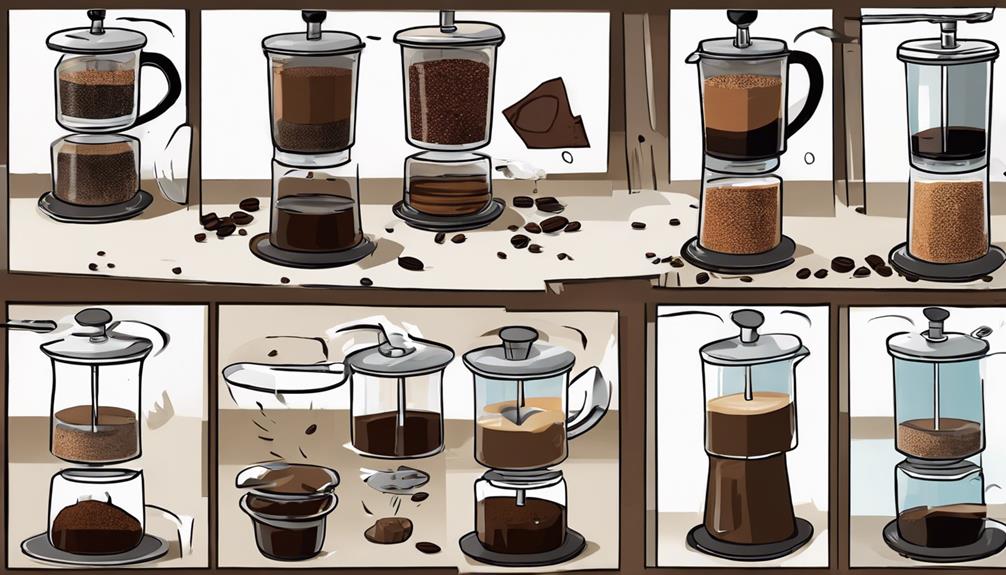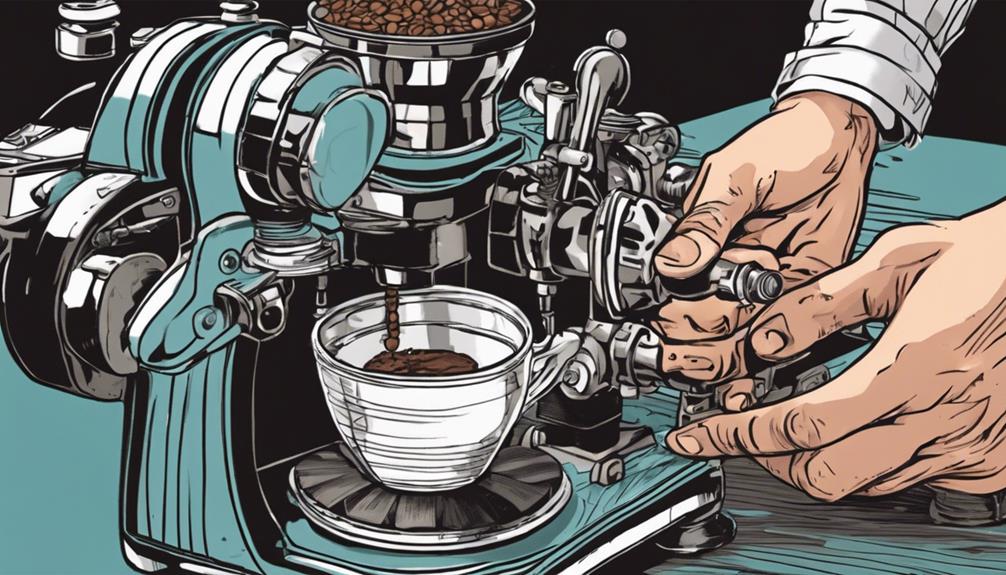To put together your coffee grinder, securely attach the hopper to hold the beans. Connect the grounds container to the bottom. Adjust the grinder’s grind size to your liking. Plug in the grinder on a stable surface. Add beans to the hopper and begin grinding. Proper assembly is essential for a perfect grind. Find more details for expert tips on optimizing your coffee grinding experience.
Key Takeaways
- Attach the hopper securely to hold coffee beans.
- Connect the grounds container to catch the grounds.
- Adjust grind size to desired setting for brewing.
- Plug in the grinder on a stable surface.
- Add coffee beans, grind, and enjoy fresh coffee.
Types of Coffee Grinders
When selecting a coffee grinder, consider the various types available to find the best fit for your brewing needs. Burr grinders, including Conical burr and Flat burr varieties, are favored for their ability to provide a consistent grind size, appealing to coffee enthusiasts seeking precision.
Conical burr grinders stand out for their quieter operation and reduced production of fines, resulting in a cleaner coffee experience. On the other hand, Flat burr grinders offer exceptional uniformity in grind size, albeit with a potentially higher price tag compared to other types of grinders.
Alternatively, blade grinders, while more budget-friendly, lack the consistency and accuracy of burr grinders. However, they're simple to use and maintain, making them suitable for beginners entering the world of home coffee grinding.
Consider your priorities – be it price, grind consistency, or ease of use – when deciding between the Burr and Blade types of coffee grinders.
Using a Coffee Grinder

To effectively utilize a coffee grinder, adjust the grind size according to your preferred brewing method for best flavor extraction.
Burr grinders, unlike blade grinders, offer precise adjustments by moving burrs closer or further apart to achieve different grind sizes.
If you opt for a blade grinder, you'll need to manually monitor and adjust the grinding time to get the desired grind consistency.
Manual grinders provide control over the grind size but can be time-consuming.
On the other hand, automatic grinders, available in both blade and burr variations, offer the convenience of consistent grinding with just the push of a button.
Matching Grind Size to Brewing Method

Adjusting the grind size according to your chosen brewing method is essential for extracting the best flavors from your coffee beans.
To match the grind size to the brewing method effectively, consider the following:
- Espresso Brewing: Opt for a fine grind size to guarantee proper extraction of flavors and aromas in your espresso shots.
- French Press Method: Use a coarse grind size for French Press brewing to prevent over-extraction during the longer steeping process, resulting in a rich and robust cup.
- Pour-Over Brewing: Select a medium grind size for pour-over methods to achieve a balanced and flavorful coffee experience.
- Turkish Coffee: For the traditional strong and aromatic Turkish coffee, grind your beans extra-fine, resembling flour, to achieve the desired intensity in each cup.
Achieving the Perfect Grind

To achieve the perfect grind, start by adjusting the grind size to match your brewing method. Experiment with different grind sizes and test the results to find the perfect balance for your taste preferences.
Consistency is key in achieving a delicious and well-extracted cup of coffee.
Grind Size Adjustments
Achieving the ideal grind size is crucial for extracting the best flavor from your coffee beans.
When adjusting the grind size on your coffee grinder, remember these key points:
- Match Grind Size to Brewing Method: Use a fine grind for espresso and a coarse grind for French Press to achieve the best extraction for each method.
- Consistency is Key: Aim for a uniform grind size to ensure an even extraction and a well-balanced cup of coffee every time.
- Make Incremental Changes: Adjust the grind size gradually in small increments to refine the extraction process and avoid significant flavor changes.
- Experiment and Taste: Feel free to experiment with different grind sizes to discover the perfect setting that suits your taste preferences and brewing method. Your grind size directly influences the flavor of your coffee, so savor the journey of finding your ideal cup!
Testing Desired Results
When testing desired results for the perfect grind, start by brewing a small amount of coffee and evaluating the taste and strength. This initial test will allow you to gauge whether the grind size suits your brewing method.
If the coffee tastes weak, adjust to a finer grind; if it's too bitter or strong, opt for a coarser grind. Keep in mind the brewing method you're using, as different methods such as espresso, drip, or French press require specific grind sizes to extract the best flavors.
Consistency is key in achieving a perfect cup of coffee. Experiment with various grind sizes to find the ideal one that suits your preferences. Make small adjustments each time and take note of the changes you make.
Maintenance and Cleaning

You need to prioritize regular maintenance and cleaning of your coffee grinder to guarantee its longevity and performance.
By removing residue like coffee oils and grounds, you can maintain the freshness and taste of your coffee.
Remember to follow the manufacturer's cleaning instructions to prevent any buildup that could affect the flavor.
Cleaning Frequency
Regularly cleaning your coffee grinder is essential for maintaining freshness and maximizing peak performance. Here are some key points to keep in mind when it comes to cleaning frequency:
- Remove Residue: Wipe down all parts of the grinder to eliminate any remaining coffee grounds and oils that could influence the flavor of your brew.
- Deep Clean Monthly: Give your grinder a thorough cleaning once a month by disassembling it and using a brush to clean hard-to-reach areas.
- Check for Clogs: Regularly inspect for any clogs in the grinder that could impede its performance and result in uneven grinding.
- Follow Manufacturer's Guidelines: Adhere to the manufacturer's cleaning instructions to ensure proper maintenance and prevent any buildup that could affect the taste of your coffee.
Proper Grinder Storage
To properly maintain your coffee grinder and secure its longevity, it's important to store it in a cool, dry place and regularly clean it to remove any residue that could impact the flavor of your coffee. Proper grinder storage in a cool place helps prevent moisture buildup, which can damage the internal components.
Cleaning your grinder regularly with a soft brush or cloth is essential to maintain its performance. Focus on cleaning the burrs and hopper, as they're areas where coffee residue and oils tend to accumulate. Avoid using water or harsh cleaning agents as they can harm the grinder's mechanisms.
Additional Features and Considerations

When selecting a coffee grinder, take into account the noise level of the machine, as it can vary among different models.
Consider these additional features and factors to make sure you choose the right grinder for your needs:
- Anti-static features: Look for grinders with anti-static features to prevent coffee grounds from clinging to surfaces, making cleanup easier.
- Hopper capacity: Opt for a grinder with a larger hopper capacity to reduce the frequency of refilling and guarantee you have enough beans for your brewing needs.
- Adjustable grind settings: Choose a grinder that offers adjustable settings for different grind sizes, such as extra-fine for espresso or coarser grinds for French press, to enhance your brewing experience.
- Expert advice: Consult with professionals like Tony Barlow, a Majesty Coffee Technical Sales Expert, who can provide valuable insights and guidance on selecting the best grinder to suit your preferences and brewing methods.
Barista Techniques and Art

Explore the complex dance of barista techniques and artistry in mastering the perfect coffee grind. Baristas employ a variety of skills to achieve consistent grinds and ideal flavor balance in every cup.
One of the key aspects mastered by baristas is the art of grind size adjustments tailored to different brewing methods. Understanding the impact of grind size on espresso extraction is essential for achieving the desired flavor profiles.
Baristas also excel in assembling and maintaining coffee grinders to guarantee they perform at their peak. By fine-tuning the grinder settings and paying attention to detail, baristas can enhance the quality of their brews.
The precision in grind size achieved by skilled baristas directly influences the taste and texture of the final coffee product. Through their expertise, baristas bring out the best in each coffee bean, creating a delightful sensory experience for coffee enthusiasts.
Immerse yourself in the world of barista techniques and art to elevate your coffee brewing skills to new heights.
Grinding Coffee 101

Master the art of grinding coffee by following these essential steps for assembling your coffee grinder. First, start by setting up your bodum coffee grinder on a clean, dry surface. Next, insert the hopper onto the top of the grinder, making sure it is securely in place. Then, carefully place the lid onto the hopper and lock it into position. Assembling a bodum coffee grinder is a simple process, but it’s important to ensure everything is properly put together before using it to grind your coffee beans.
- Attach the hopper: Assemble the hopper securely onto the top of the grinder to hold the coffee beans that you'll be grinding.
- Connect the grounds container: Attach the grounds container or portafilter holder to the bottom of the grinder to catch the freshly ground coffee.
- Adjust the grind size: Select the desired grind size on the grinder, whether you prefer a fine, medium, or coarse grind for your coffee.
- Grind the coffee: Plug in the grinder, guarantee it sits on a stable surface, add the desired amount of coffee beans to the hopper, and start grinding the coffee to achieve the perfect consistency.
Frequently Asked Questions
How Do You Set up Your Coffee Grinder?
To set up your coffee grinder, attach the hopper, adjust the grind size, and plug in the grinder. Follow the manufacturer's instructions for calibration. Double-check the grind size for your brewing method. Get ready to enjoy your freshly ground coffee!
How to Get the Perfect Grind?
To get the ideal grind, adjust the grind size settings to your preference. Confirm components are securely assembled. Test with a small batch of beans. Follow manufacturer's instructions for best results. Enjoy your perfectly ground coffee!
Why Is My Coffee Grinder Clumping?
When your coffee grinder clumps, it's like a tangled web that messes with your brew. Factors like humidity, oily beans, and static electricity can stick those grounds together. Keep it dry, clean, and adjust for that smooth grind!
How Do You Get an Even Grind With a Coffee Grinder?
To get an even grind with a coffee grinder, make sure the burrs are aligned, adjust the grind size, clean the grinder regularly, weigh your beans accurately, and experiment with different settings and brewing methods for your taste.
Conclusion
Now that you know how to assemble your coffee grinder, you're ready to set off on a journey of perfecting your coffee brewing skills.
Just like a sculptor carefully carving a masterpiece, you can now craft the perfect grind to elevate your coffee experience.
Remember, practice makes perfect, so keep experimenting and refining your technique to access the full potential of your coffee grinder.
Happy grinding!









